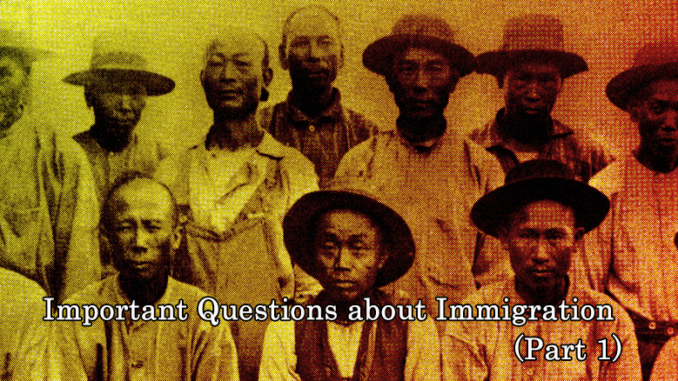
This was originally written as a single editorial, but I have decided to break it down into 3 parts to make it easier for everyone to digest.
Part 1: “A Brief History of Immigration Laws.”
Part 2: “When did we start enforcing immigration laws and why do they exist?”
Part 3: “Are immigration laws even necessary or is this all just racism and scapegoating?”
Many people have decided over the course of the last 30 or 40 years that immigration is an important Republican issue. The position seems to be that if people must come to our country at all, they should only do so formally and legally, they should be vetted, and should be upstanding citizen material (which ironically is more than we ask of ourselves). The belief is that illegals are taking our jobs, using our social services, and draining the coffers of our welfare programs. A common stance is that because illegals are breaking our laws to come here in the first place, they are already criminals and should be treated as such.
Donald J. Trump famously talked about it when he officially launched his Campaign for President of the United States.
When Mexico sends its people, they’re not sending their best. They’re not sending you. They’re not sending you. They’re sending people that have lots of problems, and they’re bringing those problems with us. They’re bringing drugs. They’re bringing crime. They’re rapists. And some, I assume, are good people.
Donald J. Trump Presidential announcement speech June 16 2015 – time.com
Well known Fox TV News Commentary hosts Tucker Carlson and Laura Ingraham, and others, have publicly stated to their audience of millions that immigration as a whole is a major problem. Laura even went so far as to say the only people who want legal immigration are progressives. It seems there is a large population of people who steadfastly agree with those statements, even though both Laura and Tucker eventually tried to walk them back.
This article is an attempt to move beyond all of that entirely, and identify the root of the problem, if there is one, by asking and hopefully answering a few core questions.
- When did we start enforcing immigration laws and why do they exist?
- Are immigration laws even necessary or is this all just racism and scapegoating?
There are other important immigration questions that have been previously addressed on TNB. Steve Wood wrote a recent editorial in The News Blender Are Mexicans Stealing Our Jobs? which cohesively addresses the employment question. In an earlier piece, Solving the Immigration Issue, Steve wrote about merit based immigration and some cultural aspects.
A Brief History of Immigration Laws
Before we can honestly answer any of these questions, we must first look at the laws that helped create them.
The first real major law with regards specifically to immigration was the The Page Act of 1875. It contained the first legislative list of undesirable people to be excluded from immigrating into the country. The law cracks down on importing Chinese labor and prostitutes by making it a felony, punishable by a $500 fine and up to a year in prison.
SEC. 4. That if any person shall knowingly and willfully contract, or attempt to contract, in advance or in pursuance of such illegal importation, to supply to another the labor of any cooly or other person brought into the United States in violation of section two thousand one hundred and fifty-eight of the Revised Statutes, or of any other section of the laws prohibiting the cooly-trade or of this act, such person shall be deemed guilty of a felony, and, upon conviction thereof, in any United States court, shall be fined in a sum not exceeding five hundred dollars and imprisoned for a term not exceeding one year.
Section 4 of The Page Act of 1875 – loveman.sdsu.edu
(Side Note.”Cooly” is an ethnic slur for an unskilled Asian laborer)
The Immigration Act of 1882, known famously as the Chinese Exclusion Act, banned the immigration of all Chinese laborers for 10 years, which was then extended for another 10 by the Geary Act (1892), which required all Chinese residents, or residents of Chinese descent, to carry permits (predecessor to a Green Card) or face deportation or imprisonment without bail or witnessing the court proceeding. According to an article published in the library of congress, the ban was made permanent in 1902. The Magnuson Act repealed the ban on Chinese immigration in 1943, allowing a quota of 105 Chinese immigrants annually.
These core pieces of legislation opened the door for other exclusionary bills such as the Immigration Act of 1903, which banned Anarchists as a response to the assassination of President William McKinley. The Bill also bans epileptics, beggars, and pimps.
The Immigration Act of 1907, bans even more people and clarifies the previous list.
SEC. 2. That the following classes of aliens shall be excluded from admission into the United States: All idiots, imbeciles, feeble minded persons, epileptics, insane persons, and persons who have been insane within five years previous; persons who have had two or more attacks of insanity at any time previously; paupers; persons likely to become a public charge;
Section 2 of the Immigration Act of 1907 – historycentral.com
Combined with the Immigration Act of 1917 (AKA the Literacy Act), the Immigration Act of 1918, and the Immigration Act of 1924 (AKA the Johnson–Reed Act), the exclusion list was expanded to include: the diseased, mentally defective, felons, misdemeanors involving moral turpitude, polygamists, Mormons, contract laborers, anyone who’s passage is comped by another, unaccompanied children under 16, alcoholics, illiterates, psychopaths, radicals, vagrants, open homosexuals, everyone living in the Asiatic Barred Zone (an area this legislation creates, which envelops all of southeast Asia and the middle east). It also expanded the definition of Anarchist to include anyone who opposes organized government and set stringent quotas on Roman Catholics, Jews, Eastern Europeans Arabs and Italians.
According to the The Department of State office of the historian, The Johnson–Reed Act, was designed to preserve the ideal of American homogeneity
The Immigration and Nationality Act of 1952 was a comprehensive bill that combined a lot of the scattered immigration legislation into one document. It set quotas for skilled laborers and added communist sympathizers to the list of banned immigrants. It killed off many of the previous restrictions on Chinese immigrants but still held the quota of 2000 persons from the Asiatic Barred Zone. It also doubled-down on barring polygamists.
It’s important to note that President Harry Truman vetoed the bill (overridden by 278 to 113 House /57 to 26 Senate), citing it as un-American and discriminatory.
Today, we are “protecting” ourselves, as we were in 1924, against being flooded by immigrants from Eastern Europe. This is fantastic. The countries of Eastern Europe have fallen under the communist yoke–they are silenced, fenced off by barbed wire and minefields–no one passes their borders but at the risk of his life. We do not need to be protected against immigrants from these countries–on the contrary we want to stretch out a helping hand, to save those who have managed to flee into Western Europe, to succor those who are brave enough to escape from barbarism, to welcome and restore them against the day when their countries will, as we hope, be free again.
Excerpts of President Harry S. Truman’s Veto of the Immigration and Nationality Act of 1952 – presidency.ucsb.edu
In no other realm of our national life are we so hampered and stultified by the dead hand of the past, as we are in this field of immigration. We do not limit our cities to their 1920 boundaries–we do not hold our corporations to their 1920 capitalizations-we welcome progress and change to meet changing conditions in every sphere of life, except in the field of immigration.
In 1953, the Supreme Court of the United States (SCOTUS) ruling in Kwong Hai Chew v. Colding, affirmed the due process rights of non citizen permanent residents.
At this time, it’s important to backpedal a bit and discuss Mexican immigration. In the early 1900’s, Mexico was getting tired of losing many agricultural workers to American Dollars and started working with the United States to fix the problem.

Around World War II, the Mexican Farm Labor Agreement (AKA the Bracero program) was born. This allowed more control over the flow of people in the agriculture field, and significantly stepped up enforcement of illegals across the border. Braceros were given set minimum wages, food, and shelter. This program lasted for 22 years and employed 5 million migrant workers. The program’s termination in 1951 eventually spawned the H-2A visa program.
Over the next 30 years with programs such as Operation Wetback, the United States rounded up and deported about 2.5 million people.
In 1982, the SCOTUS ruling in Plyler v. Doe affirmed that the Fourteenth amendment’s equal protection clause applies to illegal immigrants the moment they are considered under the jurisdiction of a state.
The Immigration Reform and Control Act of 1986 made it illegal to knowingly employ illegal immigrants and gave legal permanent residency status to all qualifying illegals in country before January 1st 1982. Various sources including the Washington Post estimate around 3 Million people received amnesty.
By 1996, there were roughly 5 Million illegals living in the United States, according to procon.org’s chart of INS estimates, which was roughly the same number living here prior to the Bill.
(Side Note. There is an unsubstantiated theory that is practically biblical in Conservative circles which stipulates that this legislation was passed through a negotiation that promised large increases in border security at a later date which never happened.)
In 2012, President Barack Obama penned an executive memo ordering DHS to create a program called Deferred Action for Childhood Arrivals (AKA DACA). This controversial action was to serve as a temporary amnesty for qualified immigrants who were brought into the United States illegally as children, allowing them time to apply for a work visa without fear of deportation.
Attempts to expand the program in 2014 were eventually halted by a SCOTUS 4-4 deadlock which defaulted back to the lower courts injunction. In September 2017, President Donald Trump, issued an order to phase out the program in 6 months, urging congress to pass a legal version that could hold up to scrutiny. Several courts put a hold on the phasing out. On August 3, 2018, The DC court ruled that The Trump administration had failed to show cause for the ending of DACA and has stayed the ruling for 20 days to allow for an appeal.
Armed with this Information we can now start answering some “Important Questions about Immigration“.
Part 2: “When did we start enforcing immigration laws and why do they exist?”

4 Trackbacks / Pingbacks
Comments are closed.